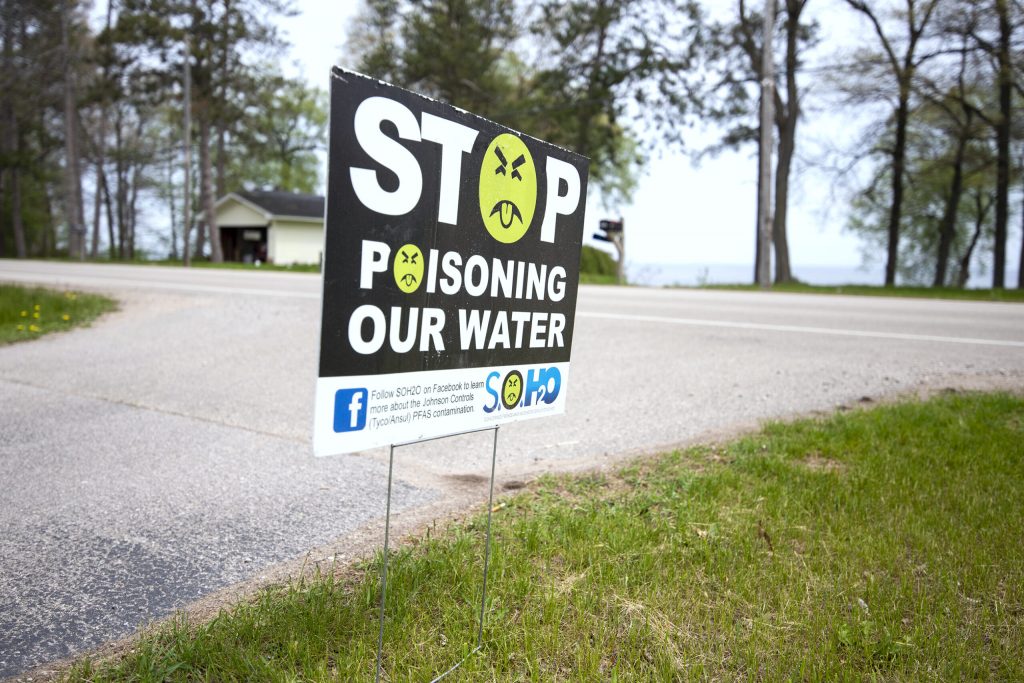Wisconsin Supreme Court Backs State Regulators of PFAS Pollution
5-2 decision says DNR has 'explicit authority to enforce' PFAS discharges.
The Wisconsin Supreme Court has upheld the authority of state environmental regulators to address PFAS contamination under the state’s spills law without first designating them as hazardous substances.
The ruling is a victory for environmental advocates and residents of PFAS-contaminated communities and a setback for the state’s largest business lobby, Wisconsin Manufacturers & Commerce, or WMC.
The rulemaking process can take years, and environmental advocates argue a 2017 law passed by Republicans has thwarted efforts to enact groundwater standards for the chemicals.
In a 5-2 decision, the court’s four liberal justices, along with conservative Justice Brian Hagedorn, found the DNR has “explicit authority to enforce a threshold for reporting the discharge of hazardous substances” regardless of whether they’ve been designated as such by the agency through an administrative rule.
“Responsible parties must, on their own initiative, immediately report a discharge to the DNR, restore the environment to extent practicable, and minimize the harmful effects on our air, lands, and waters,” Justice Janet Protasiewicz wrote.
Enacted about 50 years ago, Wisconsin’s spills law requires anyone who causes, possesses or controls a hazardous substance that’s been released into the environment to clean it up.
The Wisconsin Department of Justice argued on behalf of the DNR that a ruling in favor of WMC would hamstring the agency’s ability to protect the environment and rewrite the spills law.
In its lawsuit, WMC claimed the DNR issued guidance that was an unlawfully adopted rule that required participants in a voluntary cleanup program to address PFAS contamination. The group’s attorney said the DNR should provide a list of hazardous substances and criteria so the public knows when they’re violating the spills law.
In a concurring opinion, Hagedorn wrote that WMC’s argument was unconvincing.
Conservative Justices Rebecca Bradley and Annette Ziegler dissented, with Bradley railing against what she called the majority’s “ongoing expansion of executive power” in Wisconsin.
“The majority leaves the People at the mercy of unelected bureaucrats empowered not only to enforce the rules, but to make them,” Bradley wrote. “Americans have lived under this unconstitutional arrangement for decades, but now, the majority says, the bureaucrats can impose rules and penalties on the governed without advance notice, oversight, or deliberation.”
Wisconsin Manufacturers & Commerce Executive Vice President Scott Manley told WPR the ruling is “fundamentally unfair” because it empowers the DNR to enforce standards on hazardous substances “without telling them what the law is.”
“Government shouldn’t expect people to be mind readers and know what the DNR considers to be hazardous,” Manley said. “If the DNR considers something to be hazardous, they ought to go out and say it and tell the public so that they know how to comply with the law.”
During oral arguments, justices who ultimately ruled for the DNR dropped hints at which way they were leaning. Liberal Justice Rebecca Dallet said requiring the DNR to craft rules before taking action on hazardous substances “is insane.” Hagedorn had said there’s nothing in the law that says agencies can’t address those substances until a rule exists if the Legislature has already passed broad laws.
Since the lawsuit was first filed, federal regulators have placed limits on PFAS in drinking water and designated two of the most widely studied chemicals as hazardous substances. For now, President Donald Trump’s administration is upholding standards and a hazardous substance designation for two of the most widely studied chemicals.

Gov. Tony Evers and DNR Secretary Karen Hyun speak with Campbell residents about the local impacts of PFAS contamination during an event on Tuesday Feb. 4, 2025. Hope Kirwan/WPR
Wisconsin has set less restrictive drinking water limits for the chemicals. Even so, PFAS standards are lacking in groundwater after the DNR was forced to abandon regulations in 2023 due to excessive compliance costs.
Environmental advocates had feared a favorable ruling for WMC would affect a lawsuit brought by the Wisconsin DOJ against Tyco and Johnson Controls for violating the state’s spills law. The case was brought over the companies’ failure to report any release of PFAS when the chemicals were first discovered at Tyco’s fire training facility in 2013. Company officials maintain they believed contamination was confined to its site.
“The Supreme Court’s decision today means that polluters will not have free rein to discharge harmful contaminants like PFAS into our land, water, and air without reporting it or taking responsibility for helping clean up those contaminants,” Evers said.
Lee Donahue of the town of Campbell, which has been forced to rely on alternate water supplies after testing found high concentrations of PFAS in private wells, told WPR the court’s ruling affirms the DNR can “hold polluters responsible.”
“And given that authority, impacted communities that have been identified will hope to have a more timely and efficient cleanup of any contaminant that impacts their water,” Donahue said.
In a statement, Midwest Environmental Advocates attorney Rob Lee said the nonprofit is pleased the court “rejected WMC’s reckless attempt to undermine a bedrock environmental and public health protection.”
PFAS are a class of thousands of synthetic chemicals used in everyday products like nonstick cookware, stain-resistant clothing, food wrappers and firefighting foam. The chemicals don’t break down easily in the environment. Research shows high exposure to PFAS has been linked to kidney and testicular cancers, fertility issues, thyroid disease and reduced response to vaccines over time.
Evers has proposed a $145 million plan to address PFAS under his budget while Republican lawmakers have introduced their own bills to deal with the chemicals. Debate remains over provisions that seek to protect landowners with PFAS contamination that they didn’t cause.
Wisconsin Supreme Court sides with environmental regulators in PFAS case was originally published by Wisconsin Public Radio.
If you think stories like this are important, become a member of Urban Milwaukee and help support real, independent journalism. Plus you get some cool added benefits.
More about the PFAS Problem
- Bipartisan Push to Tell Counties Faster When Water Tests Fail - Henry Redman - Dec 19th, 2025
- MKE County: County Seeks to Sue PFAS Producers, Oil Companies - Graham Kilmer - Dec 10th, 2025
- Wisconsin Reviewing EPA-Approved Pesticides For PFAS - Danielle Kaeding - Dec 9th, 2025
- State Nears Settlement with Johnson Controls/Tyco Over PFAS Spills - Danielle Kaeding - Dec 4th, 2025
- Senate Bill Promotes Soybean-Based Firefighting Foam to Replace PFAS - Danielle Kaeding - Dec 2nd, 2025
- Test Results Show High PFAS Levels in Wisconsin’s Landfill Runoff - Danielle Kaeding - Dec 2nd, 2025
- Wisconsin Communities Get $282 Million for Drinking Water Projects - Danielle Kaeding - Nov 19th, 2025
- Gov. Evers, DNR Announce $282 Million to Improve Drinking Water Quality for Wisconsinites in 74 Municipalities - Gov. Tony Evers - Nov 18th, 2025
- Cleanup of PFAS Could Cost Wisconsin Billions - Danielle Kaeding - Nov 13th, 2025
- Cleanup PFAS Without Penalizing Innocent Landowners - Wisconsin Manufacturers & Commerce - Nov 4th, 2025
Read more about PFAS Problem here





















